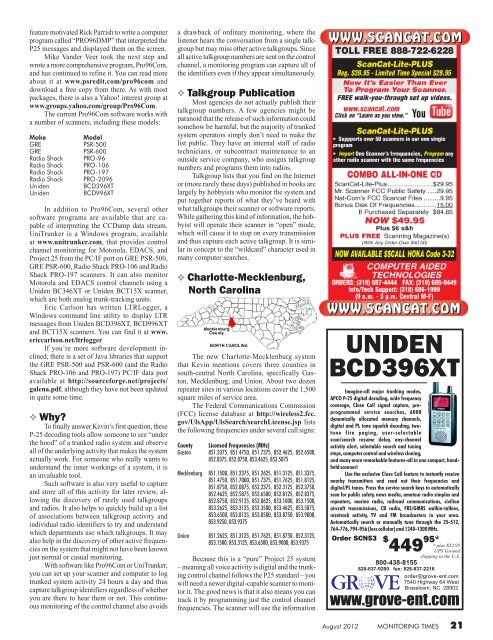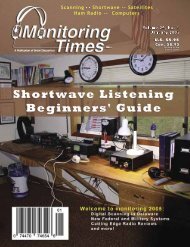RIGHT-click here - Monitoring Times
RIGHT-click here - Monitoring Times
RIGHT-click here - Monitoring Times
Create successful ePaper yourself
Turn your PDF publications into a flip-book with our unique Google optimized e-Paper software.
feature motivated Rick Parrish to write a computer<br />
program called “PRO96DMP” that interpreted the<br />
P25 messages and displayed them on the screen.<br />
Mike Vander Veer took the next step and<br />
wrote a more comprehensive program, Pro96Com,<br />
and has continued to refine it. You can read more<br />
about it at www.psredit.com/pro96com and<br />
download a free copy from t<strong>here</strong>. As with most<br />
packages, t<strong>here</strong> is also a Yahoo! interest group at<br />
www.groups.yahoo.com/group/Pro96Com.<br />
The current Pro96Com software works with<br />
a number of scanners, including these models:<br />
Make<br />
GRE<br />
GRE<br />
Radio Shack<br />
Radio Shack<br />
Radio Shack<br />
Radio Shack<br />
Uniden<br />
Uniden<br />
Model<br />
PSR-500<br />
PSR-600<br />
PRO-96<br />
PRO-106<br />
PRO-197<br />
PRO-2096<br />
BCD396XT<br />
BCD996XT<br />
In addition to Pro96Com, several other<br />
software programs are available that are capable<br />
of interpreting the CCDump data stream.<br />
UniTrunker is a Windows program, available<br />
at www.unitrunker.com, that provides control<br />
channel monitoring for Motorola, EDACS, and<br />
Project 25 from the PC/IF port on GRE PSR-500,<br />
GRE PSR-600, Radio Shack PRO-106 and Radio<br />
Shack PRO-197 scanners. It can also monitor<br />
Motorola and EDACS control channels using a<br />
Uniden BC346XT or Uniden BCT15X scanner,<br />
which are both analog trunk-tracking units.<br />
Eric Carlson has written LTRLogger, a<br />
Windows command line utility to display LTR<br />
messages from Uniden BCD396XT, BCD996XT<br />
and BCT15X scanners. You can find it at www.<br />
ericcarlson.net/ltrlogger<br />
If you’re more software development inclined,<br />
t<strong>here</strong> is a set of Java libraries that support<br />
the GRE PSR-500 and PSR-600 (and the Radio<br />
Shack PRO-106 and PRO-197) PC/IF data port<br />
available at http://sourceforge.net/projects/<br />
galena.pdf, although they have not been updated<br />
in quite some time.<br />
❖ Why?<br />
To finally answer Kevin’s first question, these<br />
P-25 decoding tools allow someone to see “under<br />
the hood” of a trunked radio system and observe<br />
all of the underlying activity that makes the system<br />
actually work. For someone who really wants to<br />
understand the inner workings of a system, it is<br />
an invaluable tool.<br />
Such software is also very useful to capture<br />
and store all of this activity for later review, allowing<br />
the discovery of rarely used talkgroups<br />
and radios. It also helps to quickly build up a list<br />
of associations between talkgroup activity and<br />
individual radio identifiers to try and understand<br />
which departments use which talkgroups. It may<br />
also help in the discovery of other active frequencies<br />
on the system that might not have been known<br />
just normal or casual monitoring.<br />
With software like Pro96Com or UniTrunker,<br />
you can set up your scanner and computer to log<br />
trunked system activity 24 hours a day and thus<br />
capture talkgroup identifiers regardless of whether<br />
you are t<strong>here</strong> to hear them or not. This continuous<br />
monitoring of the control channel also avoids<br />
a drawback of ordinary monitoring, w<strong>here</strong> the<br />
listener hears the conversation from a single talkgroup<br />
but may miss other active talkgroups. Since<br />
all active talkgroup numbers are sent on the control<br />
channel, a monitoring program can capture all of<br />
the identifiers even if they appear simultaneously.<br />
❖ Talkgroup Publication<br />
Most agencies do not actually publish their<br />
talkgroup numbers. A few agencies might be<br />
paranoid that the release of such information could<br />
somehow be harmful, but the majority of trunked<br />
system operators simply don’t need to make the<br />
list public. They have an internal staff of radio<br />
technicians, or subcontract maintenance to an<br />
outside service company, who assigns talkgroup<br />
numbers and programs them into radios.<br />
Talkgroup lists that you find on the Internet<br />
or (more rarely these days) published in books are<br />
largely by hobbyists who monitor the system and<br />
put together reports of what they’ve heard with<br />
what talkgroups their scanner or software reports.<br />
While gathering this kind of information, the hobbyist<br />
will operate their scanner in “open” mode,<br />
which will cause it to stop on every transmission<br />
and thus capture each active talkgroup. It is similar<br />
in concept to the “wildcard” character used in<br />
many computer searches.<br />
❖ Charlotte-Mecklenburg,<br />
North Carolina<br />
The new Charlotte-Mecklenburg system<br />
that Kevin mentions covers three counties in<br />
south-central North Carolina, specifically Gaston,<br />
Mecklenburg, and Union. About two dozen<br />
repeater sites in various locations cover the 1,500<br />
square miles of service area.<br />
The Federal Communications Commission<br />
(FCC) license database at http://wireless2.fcc.<br />
gov/UlsApp/UlsSearch/searchLicense.jsp lists<br />
the following frequencies under several call signs:<br />
County Licensed Frequencies (MHz)<br />
Gaston 851.3375, 851.4750, 851.7375, 852.4625, 852.6500,<br />
852.8375, 852.8750, 853.4625, 853.5875<br />
Mecklenburg 851.1500, 851.2375, 851.2625, 851.3125, 851.3375,<br />
851.4750, 851.7000, 851.7375, 851.7625, 851.8125,<br />
851.8750, 852.0875, 852.2375, 852.3125, 852.3750,<br />
852.4625, 852.5875, 852.6500, 852.8125, 852.8375,<br />
852.8750, 852.9125, 853.0625, 853.1000, 853.1500,<br />
853.2625, 853.3125, 853.3500, 853.4625, 853.5875,<br />
853.6500, 853.8125, 853.8500, 853.8750, 853.9000,<br />
853.9250, 853.9375<br />
Union 851.2625, 851.3125, 851.7625, 851.8750, 852.3125,<br />
853.1500, 853.3125, 853.6500, 853.9000, 853.9375<br />
Because this is a “pure” Project 25 system<br />
– meaning all voice activity is digital and the trunking<br />
control channel follows the P25 standard – you<br />
will need a newer digital-capable scanner to monitor<br />
it. The good news is that it also means you can<br />
track it by programming just the control channel<br />
frequencies. The scanner will use the information<br />
August 2012 MONITORING TIMES 21
















